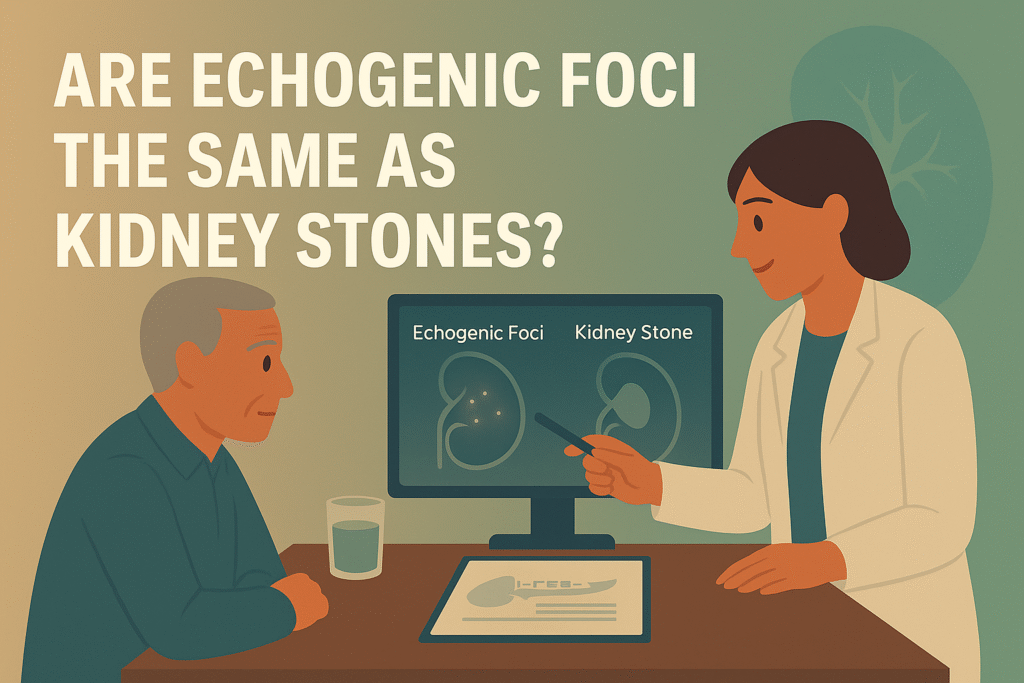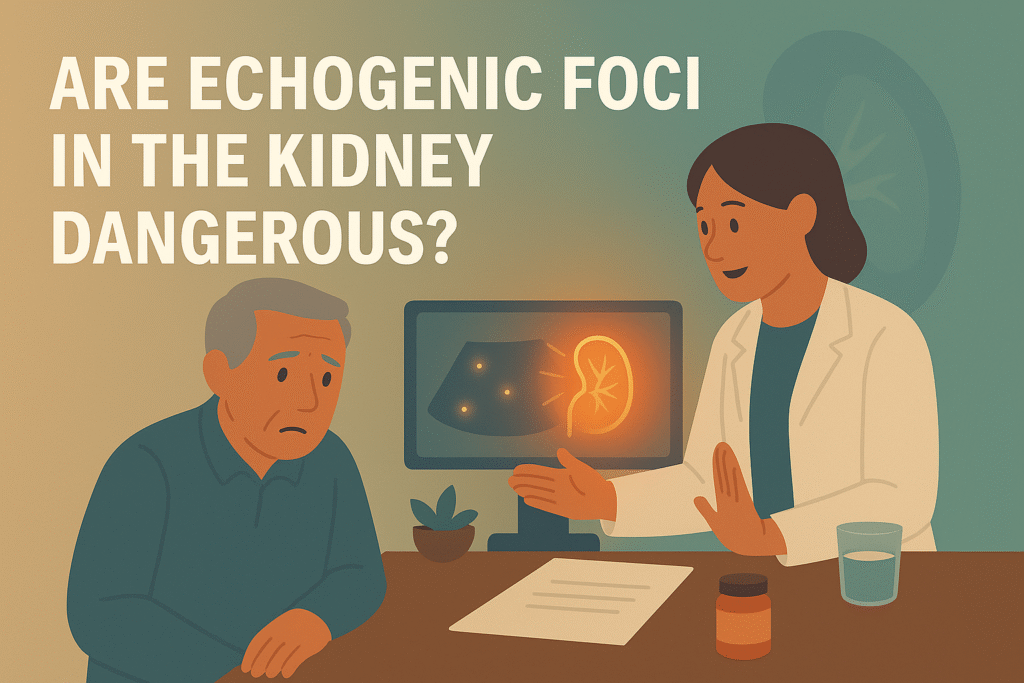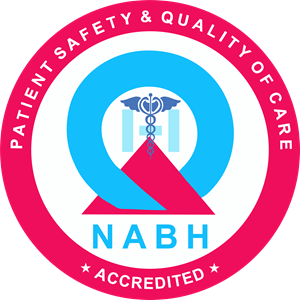Have you ever opened your ultrasound report and spotted a term like “echogenic foci in the kidney” and felt clueless?
That’s normal. Medical terms like this sound scarier than they really are.
Echogenic foci are tiny bright spots that appear on a kidney ultrasound, showing areas that reflect sound waves more than usual. But you need to relax because not every bright spot means something serious.
You might be wondering – what are echogenic foci in the kidney? Once you understand that, your next step is to shake all your worries off and talk with your doctor about what to do next.
What are Echogenic Foci in the Kidney?
The word “echogenic” means something that bounces back sound waves during an ultrasound.
“Foci” is the plural of “focus,” and it means small spots or areas.
So, if your ultrasound report says that you have these, it means there are some bright spots seen in your kidney. These spots look bright because they bounce back more ultrasound waves than the nearby tissue
Causes of echogenic foci are many, including tiny calcium deposits and kidney stones. It is normal to feel worried when you see this on your report, but don’t panic because not all echogenic foci are serious. Your doctor may suggest more tests to find out what these bright spots mean for your kidney health.
Types of Echogenic Foci
The sizes or patterns of echogenic foci in the kidney can be different, and each type may indicate different health issues or no issues at all. Here’s what each type of spot means for your kidney health:
Tiny Echogenic Foci in Kidneys
Small Echogenic Foci in Kidneys
Few Echogenic Foci in Kidneys
Non-Shadowing Echogenic Foci in Kidneys
Are Echogenic Foci the Same as Kidney Stones?

No, they are not always the same as kidney stones. They are different in nature. Echogenic foci are bright spots seen on a kidney ultrasound. Kidney stones, on the other hand, are solid mineral deposits formed inside the kidney.
That means all kidney stones appear as echogenic foci, but not all echogenic foci are kidney stones.
They can sometimes be caused by tiny calcium deposits, cysts, fat deposits, or even minor tissue changes. That’s why you need more tests, and an ultrasound alone cannot always confirm if an echogenic focus is a stone.
Your doctor may suggest a CT scan or a urine test to understand the exact cause. Small echogenic foci are usually not dangerous, but if they grow larger or cause symptoms like pain or infection, they need medical attention.
The largest echogenic foci are usually more likely to be kidney stones or larger calcium deposits, which may require treatment depending on their size and effect on kidney function.
Causes of Echogenic Foci in the Kidney
There can be many reasons behind the appearance of echogenic foci. These bright spots may be linked to harmless changes or early signs of certain kidney conditions. Here are some common causes:
Calcium Deposits or Kidney Calcification
Fat or Fibrous Tissue
Tiny Stones or Crystals
Infections or Scarring
Are Echogenic Foci in the Kidney Dangerous?

Echogenic foci in the kidney are not dangerous in most cases. Mostly, they are found by chance during an ultrasound done for another reason.
A single, small, or solitary focus is usually harmless and may not need any treatment. It could simply be a tiny calcium deposit or mild tissue change.
But multiple echogenic foci or larger bright spots may need further checks because these could be signs of kidney stones, calcification, or other conditions that affect kidney function.
Your doctor might suggest repeat scans or other tests to see if the spots change over time. So while echogenic foci can be normal, regular monitoring is important to ensure that they don’t lead to future kidney problems.
Diagnosis: How Doctors Detect Echogenic Foci?

To detect echogenic foci in the kidney, doctors start with a detailed ultrasound. This test uses sound waves to create images of your kidneys and help spot any bright areas that may suggest calcium deposits, small stones, or other issues.
If some parts of the kidney are not clearly visible during the scan, the doctor may ask you to come back for another ultrasound after a few days to get a clearer picture.
If the ultrasound shows something unusual or unclear, the doctor might recommend additional tests such as a CT scan or MRI. These scans give more detailed images and help confirm what the bright spots actually are, whether they are small stones, calcifications, or harmless changes in kidney tissue.
Once the cause of the echogenic foci is identified, your doctor will decide whether it needs treatment or just regular monitoring. As long as kidney function remains normal and no symptoms appear, echogenic kidneys are not dangerous, and people continue to live healthy lives.
Treatment for Echogenic Foci in the Kidney
The treatment for echogenic foci in the kidney depends on the cause of these bright spots. They are harmless and don’t need any special treatment in most cases to remove them. But if they are linked to kidney stones, infection, or calcium buildup, your doctor will suggest a suitable plan.
Mild Cases: Diet and Hydration
Medication for Infection or Stones
Surgery for Complications
Natural and Supportive Care
Want to know more about the treatment option. Check our detailed blog on the same: https://www.medicoexperts.com/treatment-for-increased-echogenicity-of-the-kidneys/
Can Diet Help in Reducing Echogenic Foci?

Yes, diet plays an important role in managing and reducing echogenic foci in the kidneys. Eating the right foods can prevent further calcium or stone buildup and support overall kidney function.
A kidney-friendly diet usually includes:
- Low-Sodium Foods: Too much salt can strain the kidneys and cause water retention. Choose fresh meals instead of packaged or processed foods.
- Adequate Water Intake: Drinking enough water helps flush out minerals and toxins, reducing the risk of stone formation and kidney calcification.
- Avoiding Oxalate-Rich Foods: Foods like spinach, beetroot, nuts, and chocolate are high in oxalates that can lead to stone formation. Limiting these helps protect your kidneys.
- More Fruits and Vegetables: Fresh produce provides antioxidants and supports natural detoxification.
When to See a Doctor?

Though echogenic foci in the kidney are sometimes harmless, you should not ignore them. Instead, you should see a doctor if you notice any warning signs. These signs can be
- Pain in the lower back or sides (flank pain)
- Blood in the urine (even a small amount)
- Swelling in the legs, ankles, or around the eyes
- Frequent or painful urination
- High creatinine levels or changes in urine output
Consulting a doctor is important because early treatment will save your kidneys from any harm. Early medical advice helps identify whether the echogenic foci are due to stones, infection, or another condition that needs treatment.
Even if you have no symptoms, regular checkups and follow-up ultrasounds can help monitor your kidney health and catch any changes early.
Takeaway

If your report talks about echogenic foci, don’t worry, because they are mostly normal. Most of the time, it’s not something serious. What matters is finding out the real cause and keeping track of your kidney health through regular checkups.
Take good care of your diet and lifestyle, and consult your doctor without delay. Understand what it means in your case and follow your doctor’s recommendations.
Take charge of your kidney health; get expert guidance today.
Frequently Asked Questions (FAQs):
Q1. If my ultrasound report shows echogenic foci but my kidney size and function are normal, do I still need to worry?
A. Not necessarily. Even when the kidney shows brighter areas on ultrasound (increased echogenicity or echogenic foci), yet size, cortical thickness, and kidney-function tests are normal, this can simply be harmless.
You need to ensure that there are no other signs (like decreased kidney size, thinning cortex, hindered kidney function) that point toward significant disease.
Q2. Can medications or treatments affect the appearance of echogenic foci in my kidneys?
A. Yes, some drugs or treatments may lead to structural changes in the kidney that appear as echogenic foci. For example, long-term use of lithium was shown to cause microcysts and punctate echogenic foci in the kidneys of some patients.
Q3. If only one kidney shows echogenic foci (unilateral) but the other kidney looks normal, is that better or worse?
A. If bright spots (echogenic foci) are seen in only one kidney, it’s usually less worrying than when both kidneys are affected. When both kidneys show these spots, doctors may check for underlying health or genetic issues.
In unborn babies, having bright spots in both kidneys can be more serious. Even if it’s just one kidney, it’s still important to keep an eye on it and follow your doctor’s advice.
Q4. How often should I get follow-up imaging or kidney tests if my ultrasound shows echogenic foci?
A. The follow-up for echogenic foci depends on your condition. If your kidneys are healthy and you have no symptoms, you may only need a yearly or occasional ultrasound, but if there are multiple spots or abnormal test results, your doctor may suggest more frequent scans or tests.
Q5. Will echogenic foci always show up on other scans like CT or MRI, or are they only visible on ultrasound?
A. Not always, some echogenic foci are too small or subtle to be clearly seen on other scans, but if your doctor suspects something serious, they may suggest a CT or MRI for a clearer view.
Q6. What are echogenic foci in the kidney, and can they indicate chronic kidney disease?
A. Not always. Echogenic foci in the kidney can appear in healthy kidneys too. However, when seen with other changes like kidney shrinkage or scarring, they might suggest early kidney disease and require further tests.
Q7. What are echogenic foci in the kidney, and can they cause pain or other symptoms?
A. Usually, no. Most echogenic foci don’t cause discomfort. But if they result from stones or infection, symptoms like flank pain, burning urination, or fever may occur.
Q8. What are echogenic foci in the kidney, and how often should they be monitored?
A. Monitoring depends on the cause. Benign foci may only need yearly scans, while those linked to stones or infections might require more frequent follow-ups.
Q9. What are echogenic foci in the kidney, and can they affect kidney function?
A. Typically, they don’t affect kidney performance. However, if caused by stones or infections, untreated issues could impact kidney health over time.
Q10. What are echogenic foci in the kidney, and do they always need treatment?
A. Not necessarily. Many are incidental findings that don’t require treatment. Only those linked to an underlying, cause like stones or infection may need medical care.
References
Relevant Articles For You
What Increases Creatinine Levels?
Your creatinine levels do not rise without a reason. There are signs that something in your daily routine or your body is triggering the…..Read More
Manage CKD Swelling Naturally
You may be feeling uncomfortable and frustrated due to swelling related to chronic kidney disease. But you will feel relieved after…..Read More
Treatment For Increased Echogenicity Of The Kidneys
The treatment for kidney echogenicity abnormalities depends on the underlying cause and specific condition. Here are….. Read More
Recommendations To Understand Different Treatments
Chronic Kidney Disease
In chronic kidney disease (CKD), your kidneys lose their function gradually. If the CKD reaches advanced…..Read More
Combination Therapy For CKD
Chronic Kidney Disease affects every patient differently. Our personalized care model blends advanced…..Read More
Medically Reviewed by MedicoExperts Editorial & Clinical Review Board on 29 October 2025
Medical Disclaimer: This content is for informational purposes only and is not intended as medical advice, diagnosis, or treatment. Always seek the advice of your physician or other qualified healthcare provider regarding any medical condition or dietary needs.




